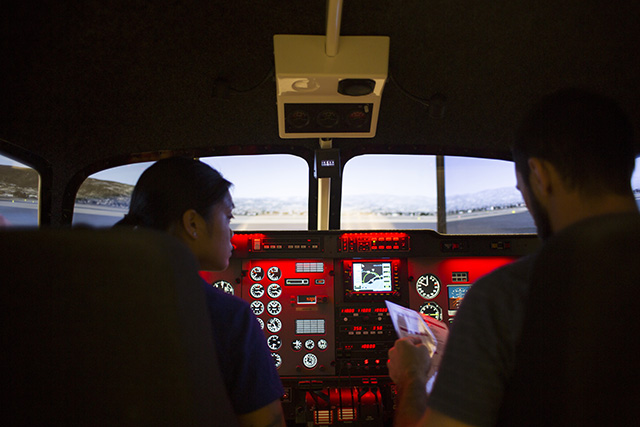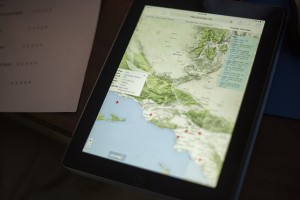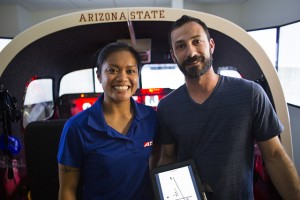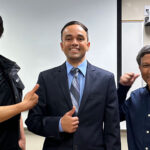
ASU aviation programs first in the world to integrate PilotEdge into flight training

Students in the Fulton Schools of Engineering aviation programs are using PilotEdge for airline crew training. Many are already private pilots, but learning to be a commercial pilot requires skills in working with another pilot in the cockpit. Photographer: Caleb Ragatz/ASU
System provides students a link to live air traffic control and real flight paths
Students training to be pilots in the aviation programs at Arizona State University have a wing up on their peers.
The university’s Polytechnic School, one ASU’s Ira A. Fulton Schools of Engineering, is the first in the world to integrate a system called PilotEdge with its flight simulator in two advanced academic flight courses. It provides a link to live air traffic control (ATC) and flight paths that simulate an experience as close to real-life as you can get.
According to instructor Jim Anderson, a retired captain from Southwest Airlines and 20-year U.S. Air Force pilot, “The use of PilotEdge was noted in our recent AABI [Aviation Accreditation Board International] as a ‘best practice,’” putting the ASU flight program at the head of the class.”
Airline pilots train in flight simulators, devices that artificially re-create aircraft flight and the environment in which it flies. They include the cockpit and flight controls, as well as a visual system that virtually replicates what it looks like when the pilot is “flying.” ASU instructors are using the ELITE Simulation Solutions King Air Simulator with PilotEdge.
“This is the first time PilotEdge has been used in this type of setting with our King Air trainer,” said Wayne Keyes, from ELITE Simulation Solutions. “We feel it provides a missing link in using simulation. The student is required to fly the aircraft while also communicating with live air traffic control, just like in the real aircraft.”

PilotEdge uses an iPad interface that allows the pilots to visually see and track their flight path. Photographer: Caleb Ragatz/ASU
Students in the aviation programs are using PilotEdge for airline crew training. Many are already private pilots, but learning to be a commercial pilot requires skills in working with another pilot in the cockpit.
With PilotEdge they practice skills such as picking up instrument flight rule (IFR) clearances, taxiing at large, complex airports, instrument approaches, the coordination of multiple practice approaches, and a wide variety of point-to-point flights.
What makes PilotEdge unique is the use of real people working all the ATC positions. Other companies have provided synthetic ATC solutions using voice recognition systems.
“They are completely ineffective in terms of placing any pressure on the pilots, causing any kind of mic fright, or building the sense that there is any kind of consequence to the pilot’s actions. There’s a huge difference between flying with synthetic ATC and human-driven ATC,” said Keith Smith, a representative from PilotEdge. “Those who have experienced PilotEdge have been blown away by the fidelity and realism it offers.”
PilotEdge controllers are a mix of active-duty and retired Federal Aviation Administration air traffic controllers, and well-trained ATC students, each with several thousand hours of experience. They are located all over the country and use software that emulates the various radarscopes used in the real world. They connect to that same network, allowing them to see the pilots on their scopes.

Students Katryna Novelozo and David Mizrahi, both military veterans, demonstrated how PilotEdge operates on a simulated flight from Arizona to the Santa Barbara airport. Photographer: Caleb Ragatz/ASU
Students Katryna Novelozo, David Mizrahi, and Tyler Faber demonstrated how PilotEdge operates on a simulated flight to the Santa Barbara airport. Faculty associate Mike Hampshire showed the iPad interface that allows the pilots to track their flight path. Once “aloft,” Anderson controlled the simulator bringing in clouds and rain to attain a low visibility condition.
“I’m currently trained to be the only pilot, and this training helps teach me how to work with someone else in an airline crew setting,” Faber said. “You learn to talk to air traffic control, to set the course. It feels very real.”
Both Novelozo and Mizrahi are military veterans – she is active duty in the U.S. Marine Corps and he served seven years in the U.S. Navy. Both hope to continue their careers as pilots or working for airlines.
For more information on the Polytechnic Schools aviation programs visit the website poly.engineering.asu.edu/aviation.
Media Contact
Sharon Keeler, [email protected]
480-727-5618
Ira A. Fulton Schools of Engineering



































